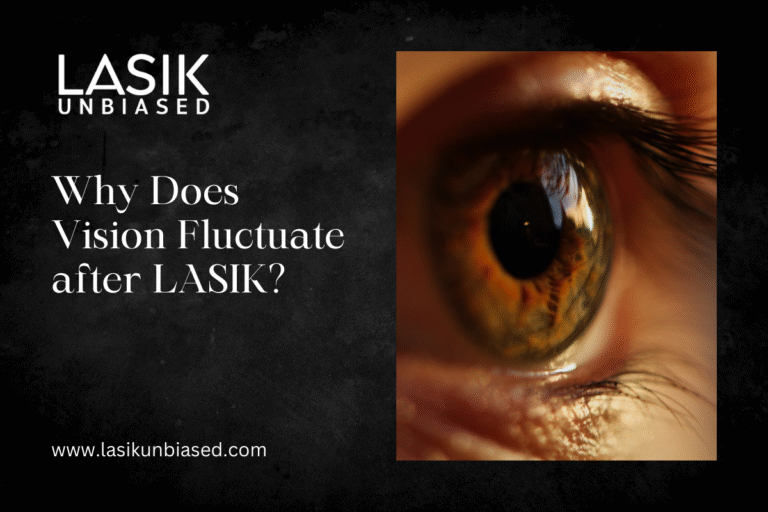Vision fluctuation after LASIK is typically a temporary occurrence caused by the natural healing process and post-surgery adjustments.
It’s your eyes adapting to the changes brought by the reshaping of your cornea.
LASIK (Laser-Assisted in Situ Keratomileusis) surgery has revolutionised vision correction, offering freedom from glasses and contact lenses for millions worldwide. However, like any surgical procedure, it comes with an adjustment period. If your vision seems a little inconsistent following LASIK, you’re not alone. Temporary vision changes are common and usually subside as your eyes heal. Here’s an in-depth look at why this happens and what you can expect during your recovery.
The Healing Process After LASIK
Healing is the primary cause of vision fluctuation following LASIK. Your cornea undergoes a reshaping process during surgery, which requires time to stabilise post-operation.
Corneal reshaping and its role in vision adjustment
The laser used in LASIK precisely removes tiny amounts of corneal tissue to correct refractive errors like nearsightedness, farsightedness, or astigmatism. After the procedure, your cornea must recover and adjust to its new shape. This healing phase can lead to temporary inconsistencies in how light is refracted off the cornea, resulting in vision fluctuations.
Dry eye syndrome
One of the most common temporary side effects after LASIK is dry eye syndrome. The surgery can disrupt the corneal nerves responsible for tear production, leading to reduced lubrication. Dry eyes may cause blurriness or inconsistent focus. Fortunately, this usually resolves as the eyes heal and nerve function improves.
Epithelial healing
The outermost layer of your cornea, called the epithelium, also undergoes healing after LASIK. Although LASIK primarily affects the deeper stromal layer, epithelial recovery can still influence surface smoothness and tear film stability, sometimes contributing to temporary visual fluctuations. Fortunately, the epithelium typically regenerates within a few days.
Factors Influencing Vision Fluctuation After LASIK
Everyone’s healing process is unique, and several factors can contribute to the degree of variation you experience.
Age and overall health
Younger patients tend to heal quicker than older ones, as age can affect the cornea’s ability to recover. Additionally, underlying medical conditions such as diabetes or autoimmune disorders can impair wound healing and may prolong the visual recovery process after LASIK.
The degree of correction required
Patients with higher refractive errors typically undergo more extensive corneal reshaping, which can lead to a longer and more variable healing process. This may result in more noticeable vision fluctuations during recovery compared to those with lower corrections.
Post-operative care adherence
Adhering to your surgeon’s post-operative care instructions is essential for ensuring a successful recovery. Skipping prescribed eye drops or failing to attend follow-up appointments can hinder healing and impact visual outcomes.
When Is Vision Fluctuation Normal?
Mild vision changes are expected and normal in the first few weeks after LASIK. You may notice slight blurriness, halos around lights, glare, or even temporary night vision problems. These symptoms typically improve within the first three months as your eyes stabilise.
The timeline for recovery
- First 24-48 hours: Vision may be foggy or blurry immediately after surgery, but it begins to clear quickly.
- First week: Most patients report significant improvement, though inconsistencies might still occur, especially at night.
- First month: Vision stabilises further, with fewer fluctuations compared to the initial weeks.
- Three to six months: By this stage, vision is typically clear and stable for most patients.
When To Be Concerned About Vision Fluctuation?
While most vision changes are part of the normal healing process, certain symptoms warrant immediate attention.
Red flags to watch out for
- Severe or worsening eye pain: Pain that doesn’t subside could indicate complications such as infection or inflammation.
- Persistent or significant blurriness: If your vision doesn’t improve after a few months, follow up with your surgeon.
- Sudden vision loss: This is rare but a medical emergency that demands prompt action.
If you experience any of these symptoms, contact your LASIK surgeon as soon as possible for a comprehensive evaluation.
Tips For Managing Post-LASIK Vision Fluctuation
While you can’t entirely eliminate fluctuation, there are several steps you can take to manage it effectively during your recovery.
Stick to your eye drop regimen
Artificial tears and medicated eye drops play a vital role in reducing dryness and inflammation. Use them as directed to support the healing process and minimise discomfort.
Take adequate rest
Your eyes need time to recover, so avoid straining them. Limit screen time and take regular breaks to prevent fatigue during the initial weeks after surgery.
Wear protective eye gear
It’s essential to protect your eyes from dust, pollution, or accidental rubbing. Use the protective goggles provided after surgery, especially when sleeping or in high-risk environments.
Stay hydrated and eat a balanced diet
Hydration and proper nutrition can aid healing. Include omega-3-rich foods like fish and flaxseeds, which are known to promote tear production and improve dry eye symptoms.
Attend follow-up appointments
Your surgeon will closely monitor your progress during follow-up appointments to ensure that your recovery proceeds as expected. These visits are essential for identifying and addressing any potential concerns early.
The Science Of Vision Stability
LASIK surgery is designed with long-term vision stability in mind. Once your cornea has healed completely, your new visual acuity should remain stable for years. However, age-related conditions like presbyopia or cataracts could still affect your vision down the line, necessitating additional treatments.
Modern advancements improving LASIK outcomes
Advancements in LASIK, such as Wavefront-guided technology and femtosecond lasers, have significantly reduced complications and enhanced precision. These technologies provide greater customisation based on individual eye anatomy, improving recovery times and reducing fluctuations.
LASIK Myths About Vision Fluctuation
There’s a lot of misinformation surrounding LASIK surgery. Here are three common myths debunked:
- “LASIK permanently damages vision during fluctuation.” False. Most fluctuations are completely normal and temporary.
- “Re-treatments are always needed.” False. Around 95% of LASIK patients achieve 20/25 vision or better without needing enhancements. Enhancements are typically considered only if visual acuity does not meet expectations after several months of healing.
- “You can’t drive or work for weeks.” False. Many patients resume daily activities within 24-48 hours post-surgery, with minimal restrictions.
Clear And Steady Sight Ahead
LASIK remains one of the safest and most effective vision correction procedures available, with high success rates and patient satisfaction. Vision fluctuation, while understandable, is almost always a temporary phase on the path to clear, stable sight.
By understanding the causes and timeline of these fluctuations, along with closely following post-surgical care advice, you can make your LASIK recovery as smooth as possible. Should you experience prolonged concerns or discomfort, never hesitate to reach out to your surgeon. Professional guidance is just as important after LASIK as it is before.
For millions of people worldwide, LASIK has provided life-changing results. If you’re considering the procedure or are currently recovering, remember that patience and care are key. The clarity and freedom of perfect sight are well worth the wait.


